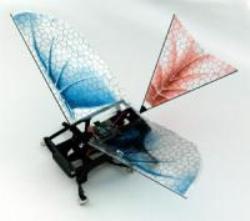A six-legged robotic bug was fitted with wings to improve its mobility at the University of California, Berkeley. While working on improving its mobility, the research team discovered new concepts on the evolution of flight. The robotic bug is called DASH, short for Dynamic Autonomous Sprawled Hexapod.
 DASH
DASH
After attaching wings to DASH, its running speed and aerial performance increased but the energy was insufficient to launch the robot from ground level. The research team was headed by Ron Fearing from the electrical engineering department at the University.
DASH is a robotic bug capable of moving at high speeds due to its light weight. It was built using inexpensive materials such as fiber board and is driven by a motor that is powered with a battery. Its compact design makes it possible to use it in areas that have space constraints or are too risky for humans to enter. The idea for designing DASH was inspired by the cockroach, however, unlike the roach it is not capable of getting into niche places. So in order to simulate movement similar to that of the roach the researchers have fitted DASH with lateral and tail wings. After fitting DASH with wings, the researchers tested it with four different combinations that include with tail only, with wing frames only to find out how the wings impacted its locomotive capabilities. The observations were that the speed of DASH doubled to reach 1.29 m/s and its ability to negotiate steeper hills having an incline angle of 16.9 m and to make a steady descent also improved. The lateral flapping wings were useful in improving the lift-drag ratio, which showed in its ability to land in a more controlled manner.
The research team was helped by a professor of integrative biology in designing the DASH with wings in order to gain the maximum speed. The inspiration for the design was obtained from the gliding movement of some animals. Some of the other robots which are being tested in the BiomimetricMillisystems Lab are the Bipedal Ornithopter for Locomotion Transitioning (BOLT). The BOLT mimics the movement of flying birds and insects.